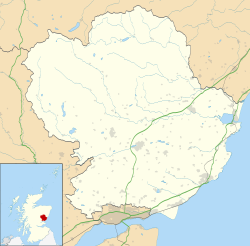Airlie Castle
| Airlie Castle | |
|---|---|
| Airlie, Angus, Scotland | |
 Drawing of Airlie Castle | |
 Airlie Castle | |
| Coordinates | 56°39′22″N 3°09′18″W / 56.6562°N 3.1551°WCoordinates: 56°39′22″N 3°09′18″W / 56.6562°N 3.1551°W |
| Grid reference | grid reference NO 2928 5220 |
| Type | Mansion |
| Site information | |
| Open to the public | Private |
| Site history | |
| Built | 15th century; rebuilt 19th century |
| Materials | Stone |
Airlie Castle is a mansion house in the parish of Airlie, Angus, near the junction of the Isla and Melgund rivers, 9 kilometres west of Kirriemuir, Angus, Scotland. A castle was built on the site in c. 1432 and was burnt out in 1640, with a mansion house built incorporating and on top of some of the ruins in c. 1792–93, and occupied today.[1] The house and the stables are Category B listed buildings[2][3] and the grounds are included in the Inventory of Gardens and Designed Landscapes in Scotland.[4]
History[]
King James I of Scotland granted lands to Walter Ogilvy of Lintrathen, Lord High Treasurer of Scotland, in 1432. Walter Ogilvy then built the castle at the confluence of the River Isla and the Melgam Water. It sits on a raised position with a steep 400 ft drop to the rivers below. A moat on the eastern approach further protected the castle. It became a stronghold and chief residence of the Ogilvies. James Ogilvy, 5th Lord Ogilvy of Airlie planned to rebuild the castle in 1564.[5]
The castle consisted of a rectangular courtyard with walls three meters thick. The east wall of the original courtyard still stands; it is about 36 metres long and 9 metres tall. An entrance gateway that now has a square tower on it sits at the north end of this wall, though the tower was built later than the original courtyard.
In 1639 at York Charles I created James Ogilvy the 1st Earl of Airlie. James refused to sign the National Covenant. Furthermore, during the Wars of the Three Kingdoms the Ogilvies supported King Charles I and the Royalist cause. Parliamentarian troops under the command of Archibald Campbell, 8th Earl of Argyll destroyed the castle in 1640; the ballad "The Bonnie Hoose o' Airlie" describes the incident. Campbell also burnt the Ogilvies' castles at Craig and Forter.
The Ogilvies did not rebuild Airlie Castle. James Ogilvy (d. 1731), the grandson of the first Earl, took part in the Jacobite rising of 1715 and was attainted; consequently, on his father's death in 1717, he was not allowed to succeed to the earldom, although he was pardoned in 1725. George II confiscated the castle.
In 1778 David Ogilvy too received a pardon and he returned to Scotland from exile in Versailles. He had a new mansion built between 1792 and 1793 that incorporated the parts of the Castle that were still standing.
Citations[]
- ^ "Airlie Castle/Airlie House". CANMORE. Retrieved 25 January 2010.
- ^ Historic Environment Scotland. "AIRLIE CASTLE (Category B Listed Building) (LB4628)". Retrieved 28 February 2019.
- ^ Historic Environment Scotland. "AIRLIE CASTLE – STABLES (Category B Listed Building) (LB4629)". Retrieved 28 February 2019.
- ^ Historic Environment Scotland. "AIRLIE CASTLE (GDL00009)". Retrieved 28 February 2019.
- ^ Contract with George Nicholson for building 'the foyr quarters of Airly', National Records of Scotland, online catalogue, NRS GD16/27/6.
- Castles in Angus
- Inventory of Gardens and Designed Landscapes
